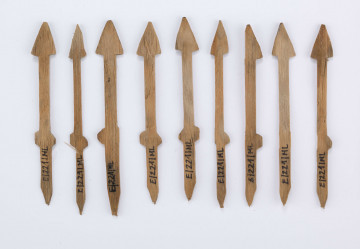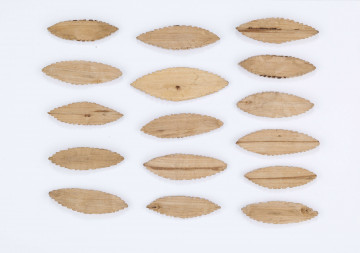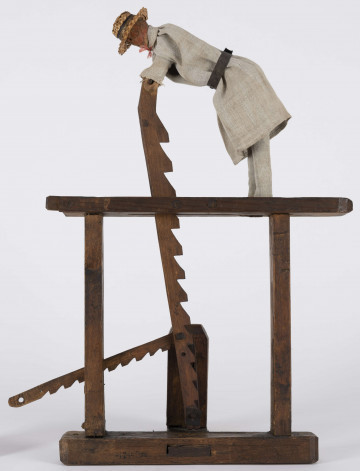
Game `Pick-up Sticks`
1901 — 1920
National Museum in Lublin
Part of the collection: Folk craft of the Lublin Region (19th/20th c.)
In addition to playing with simple toys made by children themselves or by adults (see E/180/ML, E/190/ML, E/544/ML, E/1649//ML, E/2146/ML, E/17030/ML), movement games enriched rural children's time. They were known for ‘Babka’, when a blindfolded player grabbed playmates, ‘Wolf and Goose’, which involved catching the last player clinging to the shoulders of his predecessors, and ‘Lamb’, trying to escape from a chain formed by children, ‘Sycamore’, in which players, lined up one behind the other, tried to pass under a gate from the raised hands of other players, who cut off the last of the approaching ones from the rest, or ‘Father Virgilius’ with a song, after the stanzas of which various actions were shown and imitated.
Tossing games were no less popular. The most developed and widespread were ‘Lubartów pick-up sticks’. Figurines were made of wood in the form of flat abstract shapes 1.5-8 cm long and 0.5-2 cm wide. All the bobs used in the game made up the so-called loose, which consisted of king, queen, sub-king, sub-king, pop, ‘popica’ and ‘liszki’. Their various forms constituted the corresponding point values: cattle = 1 point, pop and ‘popica’ 4 each, sub-king and sub-king 8 each, king and queen 12 each. The game consisted in each player (2-10 people) putting the whole sypa on his hand (or as much of it as he could fit), tossing it and catching one or several figures on the back of his hand. However, it was forbidden to catch figures of different species, e.g., a king with a queen, a pop with a king, and ‘liszki’ could be caught only in an even number. The caught bickers were put away and the game could be repeated. According to records from the beginning of the 20th century, there were three techniques of catching. One was to bend the hand to let the unnecessary bidders slide away, or to catch a figure in the air or in a funnel made of fingers.
The game was common at the beginning of the 20th century, especially among older country boys in the Lubartów, Podlasie and Podhale regions. Depending on the region, the figures had different names: king, bursar, lord, alderman, farmer, farmhand.
Author / creator
Dimensions
cały obiekt: height: 2 cm, width: 8 cm
Object type
toy
Technique
planing
Material
wood
Creation time / dating
Creation / finding place
Owner
The National Museum in Lublin
Identification number
Location / status

1901 — 1920
National Museum in Lublin

1901 — 1920
National Museum in Lublin

1901 — 1950
National Museum in Lublin
DISCOVER this TOPIC
Museum of King Jan III's Palace at Wilanów
DISCOVER this PATH
Educational path